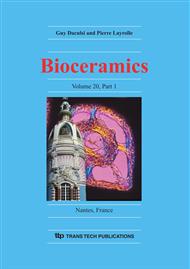p.653
p.657
p.661
p.665
p.669
p.673
p.677
p.681
p.685
In Vitro Behavior of Two Distinct Titanium Surfaces Obtained by Anodic Oxidation
Abstract:
Two different Ti oxide films produced by anodic oxidation were submitted to in vitro bioactivity and cell culture tests. The oxide films were produced in 1.0M H2SO4/150V and 1.0M Na2SO4/100V. Surfaces were found to be homogeneous and rough, with the presence of pores. Both oxide films presented anatase and rutile phases. Ti oxide film produced in Na2SO4 was rougher than the film grown with H2SO4 and composed of a rutile-rich phase. Both films were constituted by TiO2 and Ti2O3 oxides. Despite the differences observed, after 7 days, a calcium phosphate layer was precipitated on both surfaces. Indeed, these two treatment conditions seem to be efficient to spread and attach osteoblast-like cells within 4h.
Info:
Periodical:
Pages:
669-672
Citation:
Online since:
November 2007
Keywords:
Price:
Сopyright:
© 2008 Trans Tech Publications Ltd. All Rights Reserved
Share:
Citation:


